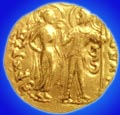
THE MAURYAN EMPIRE (322BC to 188BC)
| Ashoka | Mauryan Administration | Decline of the Mauryan Empire |
The period of the Mauryan Empire marks a new epoch in the history of India. It is said to be a period when chronology becomes definite. It was a period when politics, art, trade and commerce elevated India to a glorious height. A period of unification of the territories which lay as fragmented kingdoms. Moreover, Indian contact with the outside world was established effectively rule during these period.
The source of our knowledge about the Mauryan empire is based on
-
Arthashastra of Kautiliya
-
Sanskrit play Mudrarakshasa
-
The Jatakas of the Buddhist
-
The accounts of Megasthenes
-
The Ceylonese Chronicles the Dipavamsa and The Mahavamsa
-
The accounts of the Greeks
Arthashastra by Chanakya or Kautilya is treatise on statecraft. It gives us a picture of administration, society and the economy of the country. Mudrarakshasa is a sanskrit play by Visakadatta. It is said to be a political literature revealing the struggle unleashed by Chandragupta Maurya with the help of Chanakya to overthrow the Nandas. It is also an insight into Chandragupta life.
The Jataka and Chronicles of Ceylon gives us an idea that period.
Indika written by Megasthenes gives an account of the Mauryan capital, administrative system and social life. The rock edicts of Ashoka also provides ideas about the Mauryan rule.
Indica written by Megasthenes which exists as writings by later writers throw light on the people, government and institutions of India under Chandragupta Maurya. His topographical account of the Mauryan capital Pataliputra when he visited it as an ambassador and description of the administrative system are reliable.
The Ceylonese Chronicles, the Dipavamsa and Mahavamsa gives the accounts of the conversion of Ceylon. They also have helped in reconstructing the history of Ashoka.
Chandragupta Maurya
The Mudrarakshasha describes Chandragupta as Mauryaput.
Another account by Somadeva represents him as the son of the last Nanda monarch
from his Sudra concubine Maurya by name from which was derived the name Maurya.
The Mahavamsatika connects the Mauryans with Sakyas who belong to the
solar race of Kshatriyas. According to the Jains tradition Chandragupta was the
son of the daughter of the chief of a village of peacock  -tamers (Mayur Posakh).
The peacock figures that appear in the emblem of the Mauryas in the some punch
marked coins and sculptures testify this. Others are of the view that he was a commoner
and not a prince.
-tamers (Mayur Posakh).
The peacock figures that appear in the emblem of the Mauryas in the some punch
marked coins and sculptures testify this. Others are of the view that he was a commoner
and not a prince.
Chandragupta was brought to the limelight of the Mauryan empire by Chanakya who had a grudge against Dhananda who insulted him in the court. The Nanda dynasty had lost all its capability owing to the extravagant life led by the rulers. The tyranny that was unleashed spread an air of discontent. The defeat of Punjab in the struggle with Alexander, set the conditions for having a change in the rule.
According to Mudrarakshasha, Buddhist and puranic accounts Chandragupta defeated the Nanda army after invoking a revolution against the Nanda rulers in Patliaputra. He acceded to the throne in 321BC. His empire included Magadha and Punjab. The Junagarh rock inscription of Rudradaman proves the inclusion of the Saurastra in his empire. The Jain tradition also establishes Chandraguta 's connection with north Mysore. It also said to include the Hindukush in the west. The four satrapies also became parts of the Mauryan empire during Chandragupta Maurya. In course of 18 year Chandragupta consolidated his empire. After which he is said to have abdicated the throne and became disciple of the Jain Saint Bhadrabahu, and settled in Shravanabelagola (Mysore). After a reign of 24 years he died in about 297BC.
Bindusara
Bindusara, also called "Amitrachates" meaning slayer of enemies, by the Greeks, succeeded to the throne of the Mauryan empire after Chandragupta's abdication. He also had the opportunity of having the guidance of Chanakya who continued as minister. The period of his accession to the Mauryan throne witnessed a series of revolt by the people of Taxila. The first revolt was effected owing to the improper administration of prince Susima. To the inherited Mauryan territory of Bindusara he added parts of south.






